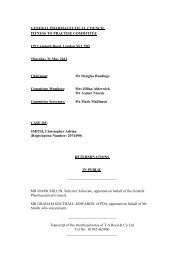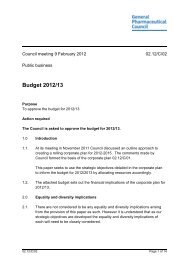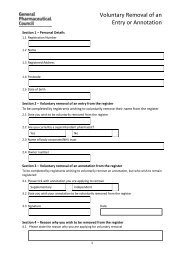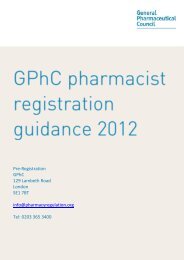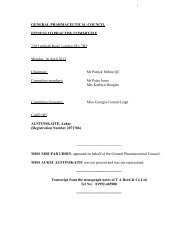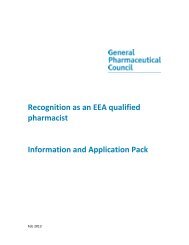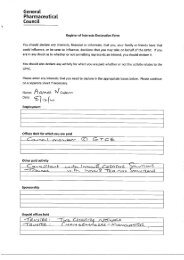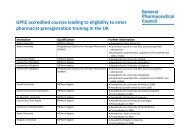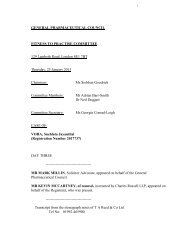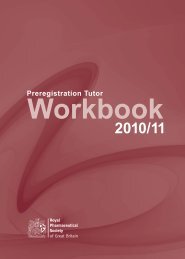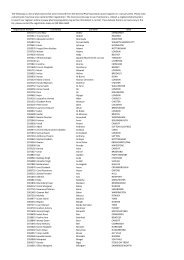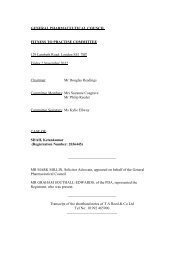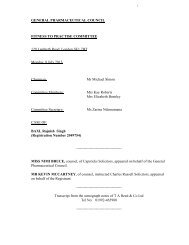Community Pharmacy - General Pharmaceutical Council
Community Pharmacy - General Pharmaceutical Council
Community Pharmacy - General Pharmaceutical Council
Create successful ePaper yourself
Turn your PDF publications into a flip-book with our unique Google optimized e-Paper software.
<strong>Community</strong><br />
An Introduction to<br />
<strong>Pharmacy</strong><br />
2010/11<br />
A resource pack for<br />
preregistration<br />
pharmacy trainees<br />
working in hospital<br />
to visit community<br />
pharmacies<br />
ORIGINALLY DEVELOPED BY:<br />
NHS <strong>Pharmacy</strong> Education and<br />
Development Committee and<br />
National <strong>Pharmaceutical</strong> Association<br />
CONTRIBUTIONS BY:<br />
Academic <strong>Pharmacy</strong> Practice Unit<br />
University of East Anglia<br />
Division of Academic <strong>Pharmacy</strong><br />
Practice<br />
University of Leeds<br />
<strong>Pharmacy</strong> Teaching Unit<br />
Guy's & St Thomas' NHS Hospital<br />
Trust<br />
National <strong>Pharmaceutical</strong> Association<br />
London <strong>Pharmacy</strong> Education &<br />
Training Service<br />
Sainsbury's <strong>Pharmacy</strong>
Contents<br />
Aims 3<br />
Introduction 3<br />
How to prepare for your training secondment 5<br />
After your training secondment placement 5<br />
Pre-visit tasks and activities for the trainee 6<br />
Section 1 - The pharmacist, pharmacy staff and other healthcare<br />
professionals 8<br />
Section 2 - The dispensary and dispensing 11<br />
Section 3 - Responding to symptoms 16<br />
Evaluation of the secondment placement 21<br />
Appendix 1 - Log of evidence 22<br />
Appendix 2 - Templates of letters 23<br />
Summary of work experience within the pharmacy 25<br />
Appendix 3 - Summary of activities 26<br />
Summary of Preregistration Performance Standards 27<br />
Evaluation of Resource Pack 29<br />
2
Aims & Introduction<br />
Aims<br />
The aim of this guide is to help you as preregistration trainees working in<br />
hospital to:<br />
• gain an insight into the practice of community pharmacy<br />
• achieve some of the Performance Standards set by the Regulator<br />
• describe the differences and similarities between the two areas of<br />
practice<br />
Introduction<br />
You may know little about the working environment of your colleagues in<br />
community practice. The community pharmacist has an increasingly wide<br />
role as a healthcare professional. Apart from the obvious activities of<br />
dispensing prescriptions and selling over the counter (OTC) medicines,<br />
community pharmacists also carry out such functions as<br />
• responding to patients' symptoms<br />
• diagnostic services such as pregnancy testing, blood pressure<br />
measurement, and testing of blood fluids<br />
• health promotion<br />
• working with general medical practitioners on prescribing issues<br />
and formulary and clinical guideline development<br />
• advisory services to local care homes<br />
• needle exchange supply for drug misusers<br />
• supply of methadone or buprenorphine to drug misusers<br />
This guide aims to help you to make the most of your secondment to a<br />
community pharmacy. You need to be disciplined in this time to get an<br />
understanding of how community pharmacists work. Depending on your<br />
previous experiences (eg vacational employment in a pharmacy) you may<br />
decide that you want to experience certain areas of the pharmacy practice<br />
more than others so the booklet is divided into sections. These reflect the<br />
main areas of community pharmacy practice.<br />
It also consists of various tasks which are denoted by ( ) which should<br />
be completed whilst at the pharmacy. There are also reflective questions<br />
denoted by ( ) which can be completed after the secondment.<br />
This framework aims not only to give you an insight into community<br />
pharmacy, but also provides a structure for your secondment. In<br />
Appendix 1 there is a master form 'Log of Evidence' for you to photocopy<br />
and record your findings, observations and answers to the tasks and<br />
reflective questions.<br />
The various tasks and questions may be used as performance evidence<br />
and have been cross-referenced to the units of the Regulator’s<br />
Performance Standards.<br />
3
In Appendix 3 there is a form to summarise the activities completed during<br />
your secondment. Fill it in as you go along!<br />
During the placement, you should also aim to develop further personal<br />
learning objectives. For example, you may see and experience things in<br />
community pharmacy which make you ask more about various aspects of<br />
hospital practice, but you may need to wait until you return to your hospital<br />
before those questions can be answered. You may look at prescriptions<br />
for conditions that you are not so familiar with working in a hospital setting<br />
and you may want to learn more about such conditions.<br />
Enjoy your placement. Have fun! Every community pharmacy is different<br />
- in size, layout, numbers and grades of staff, clientele, services provided<br />
and merchandise sold. However, whatever sort of community pharmacy<br />
you visit, you will learn much about the practice environment, which has<br />
differences from - but also similarities to - your own.<br />
Finally, please help us to help fellow preregistration trainees by completing<br />
the form 'Evaluation of the Resource Pack' after your visit.<br />
Your comments on this pack will be valuable and allow the materials to be<br />
amended or updated.<br />
Please take five minutes to complete the form (found at the back of this<br />
booklet) and return it to your tutor or the Preregistration Division,<br />
1 Lambeth High Street, London SE1 7JN.<br />
Thank you.<br />
4
How to prepare for your training placement<br />
Before the placement:<br />
• Write a letter to the community pharmacist, introducing yourself with a bit<br />
about your background and experience so far and what you would like to<br />
cover during your training placement. There are two templates of a letter<br />
for you and your tutor to use when corresponding with the community<br />
pharmacist in Appendix 2<br />
• It may be worthwhile contacting the community pharmacist by telephone<br />
two weeks prior to your visit to discuss the 'finer' details such as working<br />
hours, dress code, lunch break<br />
• Read the pack, familiarising yourself with the types of exercises in it.<br />
• Check the Regulator’s Examination Syllabus and Performance Standards<br />
• Complete the pre-visit activities<br />
• To make the most of this opportunity, prepare thoroughly by talking to<br />
your tutor, reading the appropriate sections of the Preregistration Manual,<br />
and reading relevant CPPE distance learning packages<br />
• Photocopy 'Log of Evidence' sheet. You'll need several.<br />
During the placement<br />
• Identify personal learning objectives and write these down<br />
• Discuss with the community pharmacist what you would like to get<br />
out of the secondment<br />
• Listen carefully and ask plenty of questions<br />
• Be prompt each day - impressions are important<br />
Confidentiality<br />
During the placement you may hear or have access to information about patients<br />
which is confidential - just as you do in hospital. Remember the importance of<br />
never discussing or disclosing such information to colleagues back at the hospital<br />
or to friends and relatives outside of work.<br />
After your training placement<br />
• Write a thank you letter to the community pharmacist<br />
• Complete the reflective questions and the evaluation of the visit<br />
• Look at your 'Log of Evidence' sheets and decide how you are<br />
going to deal with any learning points you identified during the visit<br />
• Complete the 'Evaluation of the Resource Pack' questionnaire<br />
This activity may provide evidence for the following<br />
Performance Standards<br />
A1 - Manage Self<br />
A5 - Demonstrate Ongoing Learning and Development<br />
B1 - Communicate Effectively<br />
5
Pre-visit tasks and activities for the trainee<br />
Please complete these before your placement in<br />
the community pharmacy<br />
1. From your own knowledge and experience so far, write down four<br />
differences and four similarities between community pharmacy and<br />
hospital pharmacy practice. Be prepared to review your lists at the end<br />
of your work experience.<br />
2. Write down:<br />
• what you want to achieve from the placement<br />
• how you will measure your success<br />
3. Read Medicines, Ethics and Practice: A guide for pharmacists; standards<br />
for good professional practice - standards for premises, dispensary<br />
design and equipment. (These standards apply equally to hospital and<br />
community pharmacy premises). Look at the section on developing and<br />
implementing SOPs’.<br />
4. Find out about the 2WHAM questioning technique<br />
6
5. a. What are the legal differences between GSL, P and POM<br />
medicines?<br />
b. Complete the following table listing medicines for each of the<br />
following systems:<br />
i) Respiratory<br />
ii) Gastro-intestinal<br />
iii) Oropharynx<br />
iv) Skin<br />
v) Ear(s)<br />
vi) Eye(s)<br />
CLASS EXAMPLE OF A MODE OF ACTION ACTIVE<br />
PRODUCT<br />
INGREDIENTS<br />
GSL<br />
P<br />
POM<br />
This evidence maybe cross-referenced to the following<br />
elements:<br />
A1 - Manage Self<br />
A5 - Demonstrate Ongoing Learning and Development<br />
7
Section 1:<br />
The pharmacist, pharmacy staff and other healthcare<br />
professionals<br />
Objectives<br />
At the end of your time in the community pharmacy you should be able to:<br />
• Identify the different types of staff within the pharmacy and outline their<br />
roles and responsibilities<br />
• Describe how the community pharmaceutical service is organised and<br />
funded<br />
• Outline the roles of key healthcare professionals within the primary care<br />
setting<br />
In a community pharmacy, there will always be a pharmacist present and a<br />
number of other support staff, which could include one or more dispensary staff<br />
and medicines counter assistants. However, community pharmacists are<br />
increasingly working with other healthcare professionals, and it is therefore<br />
important that you find out about them and their roles.<br />
Task 1 - Members of staff<br />
Talk to or find out about the following members of staff (where they exist in the<br />
pharmacy) about their roles, responsibilities and training:<br />
• Superintendent Pharmacist<br />
• Pharmacist<br />
• Medicines Counter Assistant<br />
• <strong>Pharmacy</strong> Technician<br />
• Accuracy Checking Technician<br />
• Dispensing Assistant<br />
• Preregistration trainee<br />
Key questions to ask. Note down the answers on the log sheets.<br />
• How many of each type of staff are there?<br />
• What does a typical day entail for each member of staff?<br />
• What are their main duties?<br />
• What training have they undertaken?<br />
• How do they keep their knowledge up-to-date and enhance their skills?<br />
Question for reflection<br />
Compare and contrast the roles undertaken by a technician in hospital and one in<br />
the community. What are the main similarities? And the main differences?<br />
8
Task 2 - Remuneration<br />
• Talk to the pharmacist/manager and find out how community<br />
pharmaceutical services are funded and remunerated<br />
• Prior to your visit, you should have read the Medicines, Ethics and<br />
Practice section on standards for good professional practice - standards<br />
for premises and dispensary design. Are these standards addressed<br />
within the pharmacy? Discuss with the pharmacist<br />
Question for reflection<br />
Identify any other standards that you think could usefully be introduced into<br />
Medicines, Ethics and Practice.<br />
Task 3 - Roles of other Healthcare Professionals<br />
• Apart from the pharmacist, identify the different health professionals who<br />
work in primary care.<br />
• For three of these, find out what their general role is (probably by talking<br />
to the pharmacist, because of time constraints)<br />
• Ask the pharmacist which professionals they have contact with and the<br />
reasons for these contacts<br />
• Find out how primary care is organised (eg, primary care groups) and<br />
funded (again, probably by talking to the pharmacist)<br />
Question for reflection<br />
Are there any health professionals who work in primary care but not in secondary<br />
care and vice-versa? Why?<br />
Task 4 - Communications with other Healthcare Professionals<br />
• Record any interactions which you may have with members of the<br />
primary healthcare team such as<br />
GP Diabetic Nurse Stoma Nurse<br />
Dentist Hospital Pharmacist District Nurse<br />
Practice Nurse Continence Advisor Mental Health Nurse<br />
9
Question for reflection<br />
Comment on any interaction in Task 4 and discuss with the pharmacist. What<br />
might you have done differently?<br />
What do you understand by the term 'Clinical Governance'?<br />
How is it being addressed in the community sector? Discuss the similarities and<br />
differences with your preregistration tutor.<br />
This evidence maybe cross-referenced to the following:<br />
A1 - Manage Self<br />
A2 - Manage Work<br />
A5 - Demonstrate Ongoing Learning and Development<br />
B1 - Communicate Effectively<br />
B2 - Work Effectively with Others<br />
10
Section 2:<br />
The Dispensary and Dispensing<br />
Objectives<br />
You should be able to:<br />
• Describe how stock is purchased, ordered, received and managed<br />
• Outline the steps involved in receiving, dispensing and supplying<br />
medicines to patients<br />
• Describe and complete all documentation required in the dispensing<br />
process<br />
Every dispensary is different - in layout, size and procedures. For example, each<br />
pharmacy has its own method of dealing with prescriptions and whether patients<br />
are asked to wait or come back later.<br />
Task 1 - Stock Control<br />
• Where does the community pharmacy obtain its medicines from?<br />
• How frequent are the deliveries?<br />
• How are stock levels controlled?<br />
• How is stock ordered?<br />
• How are decisions made to use different suppliers and why?<br />
• How is stock stored and rotated? What systems are in place?<br />
• How is missing/faulty/incorrectly ordered stock dealt with?<br />
• What happens when a supplier is out of stock of one or more items?<br />
• Where would the pharmacy obtain the following special items:<br />
- Made to measure compression hosiery<br />
- Catheters/stoma<br />
- Special extemporaneous preparations<br />
- Trusses<br />
Give details of the suppliers and time taken for delivery.<br />
• How does the pharmacy dispose of unwanted medicines including CD<br />
medicines?<br />
Question for reflection<br />
Are there any differences in the types of stock held in the dispensary between the<br />
community pharmacy you visited and your hospital? For example, a community<br />
pharmacy may stock a greater variety of preparations for skin conditions. Identify<br />
any differences such as these and explain why you think these differences exist.<br />
11
Task 2 - Receiving a Prescription<br />
• What are the current NHS prescription charges?<br />
• Who is exempt from prescription charges?<br />
• What are the prescription charges and professional fees for the following<br />
items:<br />
3 Salbutamol Inhalers<br />
1 pair of Thigh Length Class 2 Stockings<br />
20 Diazepam 5mg Tabs and 20 Diazepam 10mg Tabs (written on 1<br />
prescription)<br />
3OP Microgynon 30 Tabs<br />
1op Prempak C 0.625 Calendar pack.<br />
Question for reflection<br />
Mrs Jones hands in a prescription for Evorel-Sequi and is querying why she is<br />
being charged for 2 items. How would you deal with this situation? Write down<br />
the points you would cover with this lady.<br />
Task 3 - Point of Dispensing Checks<br />
• Identify the main types of exemptions<br />
• How would you handle a customer not declaring exemption?<br />
• What are<br />
- prepayment certificates?<br />
- refund of charges?<br />
• What paperwork is involved in applying for prepayment certificates?<br />
• What documention is required for refund of prescription charges?<br />
Task 4 - Forgeries<br />
• What factors might lead you to suspect that a prescription was<br />
fraudulent?<br />
• How would you deal with a person presenting a suspect prescription?<br />
Task 5 - Computer Records<br />
• Evaluate and explain the different types of information kept on a PMR<br />
• Discuss with the pharmacist the issue of confidentiality in general and in<br />
relation to PMRs in particular<br />
• How does the computer system keep information relevant to the New<br />
<strong>Pharmacy</strong> Contract<br />
Reflective Questions<br />
What do you think are the possible benefits of using the PMRs for the following<br />
groups: Pharmacists, GPs and the patients?<br />
How and where is information about patients' medication kept in hospital? Identify<br />
advantages and disadvantages of both types of system.<br />
12
Task 6 - The Dispensing Procedure<br />
Dispense at least 10 prescriptions and describe the steps involved using the<br />
following headings:<br />
• Receive the prescription<br />
• <strong>Pharmaceutical</strong> assessment<br />
• Dispensing the items<br />
• Supplying the items (including any advice given)<br />
Compare these steps with the dispensary’s SOPs<br />
Wherever possible keep a copy of the prescriptions (but don't forget patient<br />
confidentiality, including the removal of any bar codes)<br />
What checking systems are in operation?<br />
How are 'owing medicines' dealt with?<br />
Discuss with the pharmacist the procedure for reporting ADRs<br />
Task 7 - Endorsement of Prescriptions<br />
Endorse at least 10 prescriptions. Keep a copy of the prescription, again make<br />
the prescription anonymous, with the endorsement and relate the endorsement to<br />
the relevant part or clause of the Drug Tariff.<br />
Reflective Exercise<br />
Using the Drug Tariff, the NPA Guide to the Drug Tariff or relevant company<br />
literature, explain what the following parts of the Drug Tariff cover and give an<br />
example of each:<br />
England & Wales<br />
• Discount Not Given (DNG)<br />
• Broken Bulk<br />
• Out of Pocket Expenses<br />
• Reconstitution of granules or<br />
powders before dispensing<br />
• Calendar Packs or Special<br />
Containers<br />
• Multiple Prescription Charges<br />
(England only)<br />
• Out of Services Payment<br />
• Drugs and other substances<br />
not to be prescribed under the<br />
NHS <strong>Pharmaceutical</strong> Services<br />
• SLS<br />
• Borderline Substances·<br />
• Additional Fees<br />
Scotland<br />
• Zero Discount<br />
• Dressings<br />
• Appliances<br />
• Compression Hosiery<br />
• Incontinence Appliances<br />
• Chemical Reagents<br />
• Multiple Charges<br />
• Drugs and other substances<br />
not to be prescribed under the<br />
NHS <strong>Pharmaceutical</strong> Services<br />
• SLS<br />
• Borderline Substances<br />
• Additional Fees<br />
• Calendar Packs or Special<br />
Containers<br />
• Multiple Prescription Charges<br />
13
Task 8 - Record Keeping<br />
What records must be kept for the following prescriptions:<br />
• A private prescription for a human being<br />
• A veterinary prescription<br />
• A CD prescription<br />
• An addict’s prescription<br />
Task 9 - Emergency supply of POM at the request of a patient<br />
It is a legal requirement that a pharmacist has interviewed the patient and makes<br />
the decision to supply a prescribed medicine without a prescription. To cover<br />
criterion C1.10 you must organise with the pharmacist:<br />
• Arrangements to listen to the interview (with the patient's consent)<br />
• Dispensing the product<br />
• Making the entry in the register<br />
An emergency supply may not occur during your community secondment. In this<br />
case ask the pharmacist to carry out a simulation of an emergency supply.<br />
• Describe the procedure followed by the pharmacist when dealing with an<br />
emergency supply (NB: care with confidentiality)<br />
Reflective Exercise<br />
• Using the MEP discuss the conditions that apply to emergency supplies<br />
of POMs at the request of a patient.<br />
• Differentiate between emergency supplies made at the request of a<br />
patient and at the request of a doctor.<br />
Task 10 - End of Month Procedure<br />
• Describe the end of the month procedures for sending prescriptions for<br />
pricing and remuneration - keep copies of the documentation involved<br />
(even if you are not in the pharmacy when it actually happens).<br />
• When do community pharmacists receive remuneration for each month's<br />
prescriptions?<br />
• How is the remuneration calculated?<br />
Task 11 - Specialist Services<br />
14<br />
• Identify any specialist services available from the pharmacy (e.g. needle<br />
exchange, hosiery, stoma care, collection and delivery of prescriptions,<br />
domiciliary visiting, prescribing advice and support to GPs).<br />
• For two of these, discuss with the pharmacist what is involved. For<br />
example, what procedures are involved in delivering the service? How<br />
do patients benefit from the service? How does the pharmacist benefit?
Task 12 - Advanced and Enhanced Services<br />
• Identify any advanced or enhanced services provided in the pharmacy.<br />
• For one of these, discuss with the pharmacist what is involved.<br />
Task 13 - The Role of the community pharmacist in the<br />
provision of <strong>Pharmaceutical</strong> Care<br />
Choose two regular patients who bring in prescriptions to be dispensed and using<br />
the information sources available:<br />
• Link the drugs to possible medical conditions.<br />
• Is this the most effective treatment for the indication?<br />
• Is the dose for each medicine appropriate or not?<br />
• What are the potential side effects from each of the medicines?<br />
• Are there any potential drug interactions?<br />
• What advice would you give to these patients about taking their<br />
medication and lifestyle?<br />
Reflective Question<br />
Therapeutic outcomes can be easily assessed using a variety of tests obtained<br />
through a community pharmacy.<br />
Consider the following patients:<br />
Mrs K - she has a regular prescription for Salbutamol and Beclomethasone 200<br />
inhalers. She is a heavy smoker.<br />
Mr S - he has a regular prescription for insulin injections and is overweight.<br />
Devise a care plan for these two patients.<br />
Task 14 - Standard Operating Procedures (SOPs)<br />
Discuss with the pharmacist the purpose and importance of SOPs. Jot down your<br />
thoughts. Ask the pharmacist to show you the SOP for dispensing - what are the<br />
main points? How does this SOP differ from the SOP for dispensing in your<br />
hospital? - jot down the main points.<br />
15
This evidence may be cross referenced to the following<br />
elements:<br />
A1 - Manage Self<br />
A2 - Manage Work<br />
A3 - Manage Problems<br />
A4 - Demonstrate a Commitment to Quality<br />
A5 - Demonstrate Ongoing Learning and Development<br />
B1 - Communicate Effectively<br />
B2 - Work Effectively with Others<br />
C1 - Manage the Dispensing Process<br />
C2 - Provide Additional <strong>Pharmaceutical</strong> Services<br />
Section 3:<br />
Responding to Symptoms<br />
Objectives<br />
You should be able to:<br />
• Identify the communication skills required for responding to symptoms<br />
and patient queries<br />
• Explain the benefits and drawbacks of protocols for symptom response in<br />
the community pharmacy<br />
• Understand how to advise members of the public on health issues<br />
• Identify the separate roles of the medicines counter assistant and the<br />
pharmacist in symptom response<br />
Responding to symptoms and selling over the counter medicines is often<br />
considered to be one of the major ways in which community pharmacy practice<br />
differs from hospital pharmacy. Unless you have a pharmacy selling medicines<br />
within your hospital, this may be an area you feel you know little about. Certain<br />
issues such as opportunities for health promotion (eg, smoking cessation,<br />
nutritional advice) may come up more frequently - or at least from a different<br />
perspective - in community pharmacy. However, handling patient queries and the<br />
communication skills involved in this are essentially the same in both<br />
environments.<br />
Task 1 - Dealing with Customers<br />
Deal with three of the following customers:<br />
• Pregnant women<br />
• Those requesting medicines by names<br />
• Those requesting medicines by symptoms<br />
• Referrals to pharmacist<br />
• Sales refused and why<br />
• Requests on behalf of another person<br />
16<br />
Record brief details of each dialogue and outcome.
Reflective Question<br />
Which customers were referred to the pharmacist? Would you have referred any<br />
other customers? Discuss with the pharmacist.<br />
Task 2 - Responding to Symptoms<br />
Give examples of where you provided advice or supplied OTC medicines for<br />
conditions affecting:<br />
• Respiratory tract<br />
• Gastro-intestinal tract<br />
• Oropharynx<br />
• Skin<br />
• Ear(s)<br />
• Eye(s)<br />
• Musculoskeletal and connective tissue<br />
• Women<br />
• Children<br />
Task 3 - Protocol<br />
The community pharmacy must use a protocol for responding to symptoms. The<br />
2WHAM approach is frequently used by medicines counter assistants. If you are<br />
not familiar with this approach, ask one of the pharmacy staff to explain.<br />
• Devise your own protocol for symptom response.<br />
Reflective question<br />
How does your protocol differ from the one used in the pharmacy? Why and how<br />
do you think yours is an improvement?<br />
Task 4 - Care Groups<br />
• Record your interaction with one of the following customers who is<br />
asking for an OTC medication:<br />
Patient with asthma<br />
Patient with diabetes<br />
Patient with hypertension<br />
17
Reflective question<br />
Discuss the issues that emerged in the interactions with the pharmacist. How do<br />
you think the interactions went from the perspective of the patient and the<br />
pharmacist? What might you have done differently?<br />
Task 5 - Travelling Healthcare Advice<br />
Often pharmacists are asked to provide medication and information to customers<br />
who are travelling abroad, especially prophylaxis against malaria. Whether you<br />
have an opportunity to deal with a customer or not find out about the following:<br />
• Where can you find out about malaria prophylaxis?<br />
• List the antimalarial tablets available (note which are POM and P<br />
medicines)<br />
• What factors determine the choice of drugs recommended?<br />
• What advice should be given to a customer about taking the antimalarial<br />
drugs?<br />
• What advice should be given on avoidance of mosquito bites?<br />
Task 6 - Health Promotion<br />
Health promotion activities should be a significant part of a community<br />
pharmacist's role.<br />
• Identify (by asking the pharmacist) which health promotion activities the<br />
pharmacy has been involved in during the last year. (These could<br />
include local/national campaigns and/or interactions with individual<br />
patients)<br />
• Record an interaction where you have had to help a customer<br />
considering smoking cessation.<br />
Reflective question<br />
Discuss the issues raised in the interaction with the pharmacist. What are the<br />
factors that might encourage/discourage that particular customer to give up<br />
smoking?<br />
Task 7- Mother and Child<br />
Parents and children often form a significant proportion of the clientele in a<br />
community pharmacy and there is a clear need to take special care in advising on<br />
their particular health care needs.<br />
18
Looking at medicines suitable for babies and children, identify the following:<br />
• What are the recommendations for coughs and colds in infants and<br />
children<br />
• Analgesic preparations available for babies and children (liquid and<br />
tablets) - note down active ingredients and recommended doses<br />
• Three different topical preparations available for teething infants - list the<br />
active ingredients<br />
• Products available for babies and children suffering from diarrhoea.<br />
Breast-feeding is the best. However there are mothers who are unable to or who<br />
want to bottle-feed their baby. Most pharmacies sell a wide range of baby milks<br />
and pharmacists are often asked advice on infant feeding.<br />
• List three main types of baby milk and the suitability of each for infants of<br />
different ages from 0-12 months<br />
• What commercial baby foods are suitable for: weaning; an infant of 6<br />
months; an infant of 12 months<br />
• What other key health care professionals are involved in the care of<br />
babies and children. Discuss this with the pharmacist.<br />
Task 8 - Other Areas<br />
• List the different types of wound products available for OTC sales (eg<br />
bandages, dressings, plasters and other First Aid items)<br />
• When would you recommend these products?<br />
• When would you NOT sell these products?<br />
• List the main types of dietary supplements (including the different types<br />
of vitamins and minerals and herbal preparations) and identify one<br />
possible indication for each<br />
• Find out about the range of 'Living Aids' available to customers who are<br />
partially sighted, incontinent or disabled.<br />
Task 9 - Business Management Issues<br />
A <strong>Community</strong> Pharmacist must also have management skills to ensure their retail<br />
business performance is optimum. This involves a lot of legislation.<br />
Discuss with the pharmacist:<br />
• Staff Management including employment legislation, recruitment and<br />
training<br />
• Purchasing of stock/stock control<br />
• Merchandising<br />
• Health and Safety at Work<br />
19
This evidence may be cross-referenced to the following<br />
elements:<br />
A1 - Manage Self<br />
A2 - Manage Work<br />
A3 - Manage Problems<br />
A4 - Demonstrate a Commitment to Quality<br />
A5 - Demonstrate Ongoing Learning and Development<br />
B1 - Communicate Effectively<br />
B2 - Work Effectively with Others<br />
C1 - Manage the Dispensing Process<br />
C2 - Provide Additional <strong>Pharmaceutical</strong> Services<br />
20
Evaluation of the placement<br />
• List five main points you have learnt about community pharmacy during<br />
your experience.<br />
• Review your objectives for the placement. Were they fulfilled or not? If<br />
not, why not? Were they unrealistic? Were there time constraints?<br />
• Review the differences and similarities you identified (before your CSE<br />
experience) between hospital and community pharmacy practice. Do<br />
you want to change your list?<br />
• Look at your learning needs listed and identify how you intend to action<br />
these.<br />
• Identify how your experience of working in hospital pharmacy has<br />
highlighted any action points for use in community pharmacy.<br />
Remember to complete the 'Evaluation of the Resource Pack' questionnaire.<br />
21
APPENDIX 1<br />
Log of Evidence<br />
Preregistration Record of Evidence Sheet<br />
Ref No:........................<br />
Prereg name<br />
Section<br />
Date<br />
Any relevant information should be attached to this sheet. (Don't forget confidentiality)<br />
Description of event/situation: Performance Agreed<br />
standards claimed by<br />
observer<br />
Learning points/self assessment:<br />
Signatures: Prereg: Date:<br />
Trainer/Observer:<br />
Date:<br />
22
Appendix 2<br />
Template of letters<br />
Letter 1 - Introduction letter for the supervising community<br />
pharmacist from hospital pharmacist.<br />
Dear (<strong>Community</strong> Pharmacist)<br />
Thank you for providing an opportunity for our preregistration trainee to gain some<br />
experience in your community pharmacy. As you will realise, preregistration<br />
trainees come from a variety of backgrounds and may know little about<br />
community pharmacy practice. The information booklet provided for the trainee<br />
contains a number of tasks to help give an insight into community pharmacy and<br />
covers sections on:<br />
• The pharmacist, pharmacy staff and other healthcare professionals.<br />
• The dispensary and dispensing<br />
• Responding to symptoms<br />
• Management Issues<br />
The trainee should be able to complete the booklet on their own, but they are<br />
asked to discuss some aspects of the tasks with you and your staff, so we hope<br />
that you will be able to put some time aside to help them improve their<br />
understanding of pharmacy in the community. Please can you also witness the<br />
trainee in action and validate their work by signing the appropriate log sheets.<br />
We hope that this cross sector work experience will provide mutual benefit by<br />
promoting:<br />
• Improved cross disciplinary communications<br />
• Better professional understanding<br />
• The sharing of good practices.<br />
Thank you again for your time and trouble.<br />
Yours faithfully<br />
23
Letter 2 - Letter of Introduction from Preregistration Trainee to<br />
<strong>Community</strong> Pharmacist.<br />
Dear<br />
Thank you for agreeing to provide me with an opportunity to experience<br />
community pharmacy practice during the period (date) ………….to<br />
(date)……………..<br />
I enclose a summary of my current and past work experience within<br />
pharmacy for your information. Please could you confirm the hours of<br />
work and let me know if there is any dress code/uniform required.<br />
I will be using the booklet, available on the Regulator’s website, which<br />
helps to identify and address my likely training requirements in a<br />
community pharmacy. It has been developed jointly by hospital and<br />
community pharmacists and contains tasks for me to complete in order to<br />
find out more about the community pharmacy. I will bring a copy with me<br />
for you to look at. If possible, I would be particularly interested in gaining<br />
experience in the following areas:<br />
• ……………………..<br />
• ……………………..<br />
• …………………….<br />
• …………………….<br />
• …………………….<br />
I look forward to hearing from you in due course.<br />
Yours sincerely<br />
24
SUMMARY OF WORK EXPERIENCE WITHIN PHARMACY<br />
Name:<br />
Addresses: (you need to make it clear where you can be contacted)<br />
Current work address:<br />
Telephone Number:<br />
Fax:<br />
E-mail address:<br />
Current home address:<br />
Telephone Number:<br />
Fax:<br />
Current experience:<br />
I have completed …. weeks' preregistration training with my current<br />
placement during which I have had experience of the following:<br />
• ………………….<br />
• ………………….<br />
• ………………….<br />
Previous experience:<br />
My past work experience within pharmacy includes:<br />
• ………………….<br />
• ………………….<br />
• ………………….<br />
25
Appendix 3<br />
Summary of Activities<br />
<strong>Pharmacy</strong> Name:<br />
<strong>Pharmacy</strong> Address:<br />
Pharmacist Name:<br />
Date:<br />
Date Activity Standards Covered Signature<br />
26
Summary of Preregistration Performance Standards<br />
For a complete list of performance criteria, ranges and underpinning<br />
knowledge refer to the preregistration workbook<br />
Unit A Personal Effectiveness<br />
A1<br />
Manage self<br />
A1.1 Behave in a manner consistent with membership of the profession<br />
A1.2 Manage your time effectively<br />
A1.3 Recognise your personal and professional limitations and refer appropriately<br />
A1.4 Respond with willingness and flexibility to new situations and to change<br />
A1.5 Remain composed and personally effective in all situations<br />
A1.6 Make decisions which demonstrate clear and logical thought<br />
A1.7 Take responsibility for, and accept outcomes of, your own decisions<br />
A1.8 Amend your behaviour, when necessary, based on evaluation of your performance by<br />
yourself or others<br />
A2<br />
Manage work<br />
A2.1 Carry out tasks effectively<br />
A2.2 Approach tasks and situations in accordance with the law and with the Regulators Standards<br />
of Conduct, Ethics and Performance.<br />
A2.3 Follow work systems correctly<br />
A2.4 Use resources effectively<br />
A3<br />
Manage problems<br />
A3.1 Recognise and define actual or potential problems<br />
A3.2 Identify workable options to resolve the problem<br />
A3.3 Select the best solution, based on sound analysis and appropriate evidence<br />
A3.4 Suggest and, if appropriate, implement solutions to problems<br />
A3.5 Evaluate the outcome of the solution after implementation, and if necessary redefine the<br />
problem<br />
A4<br />
Demonstrate a Commitment to Quality<br />
A4.1 Work to an acceptable standard when preparing products and delivering services<br />
A4.2 Check your own work effectively<br />
A4.3 Minimise error by others through effective supervision<br />
A4.4 Identify and rectify mistakes promptly and effectively (own and others)<br />
A4.5 Minimise health and safety risks to yourself and others<br />
A4.6 Uses evidence to inform practice<br />
A4.7 Undertakes effectively a small, planned audit assignment<br />
A5<br />
Demonstrate Ongoing Learning & Development<br />
A5.1 Identify and prioritise your own learning and development<br />
A5.2 Develop your own plans with SMART learning objectives, to meet identified needs<br />
A5.3 Use learning and development opportunities<br />
A5.4 Evaluate whether learning objectives met & identifes further learning needs<br />
A5.5 Identify your further learning needs<br />
A5.6 Record your own learning and development process and outcomes<br />
A5.7 Applies learning to practice<br />
27
Unit B Interpersonal skills<br />
B1 Communicate Effectively<br />
B1.1 Communicates comprehensively, & with understanding, in English (spoken&written)<br />
B1.2 Behave in a polite and helpful manner<br />
B1.3 Sensitively approach people who need or who may need assistance<br />
B1.4 Elicit all relevant information by the use of appropriate questions<br />
B1.5 Listen effectively to the whole message (including body language and tone)<br />
B1.6 Respect and observe confidentiality<br />
B1.7 Act appropriately in response to spoken and unspoken needs of others<br />
B1.8 Behave in a manner which instills confidence<br />
B1.9 Behave assertively<br />
B1.10 Use appropriate body language<br />
B1.11 Provide information and advice appropriate to the needs of the recipient(s)<br />
B1.12 Handle conflict appropriately<br />
B2 Work effectively with others<br />
B2.1 Acknowledge the ideas and opinions of others and act on them when appropriate<br />
B2.2 Present your own ideas and opinions appropriately (verbally & in writing)<br />
B2.3 Meet commitments made to others within agreed deadlines<br />
B2.4 Give constructive feedback to others (positive & negative)<br />
B2.5 Secure help from others when necessary in an appropriate manner<br />
B2.6 Assist others when necessary<br />
B2.7 Delegates tasks appropriately<br />
B2.8 Supervises others in an appropriate manner to ensure agreed outcomes achieved<br />
B2.9 Uses knowledge & skills effectively to help others learn<br />
Unit C Medicines and Health<br />
C1<br />
Manage the Dispensing Process<br />
C1.1 Correctly receive prescriptions<br />
C1.2 Check the prescription is valid<br />
C1.3 Assess the prescription for safety and clinical appropriateness<br />
C1.4 Resolve any identified problems appropriately<br />
C1.5 Perform calculations correctly<br />
C1.6 Assemble the prescription correctly<br />
C1.7 Supply extemporaneously prepared products according to the correct formula<br />
C1.8 Correctly issue dispensed item(s) to patient or representative, with appropriate information<br />
and advice.<br />
C1.9 Ensure stock is managed correctly<br />
C1.10 Respond appropriately to requests to dispense prescription-only items without a prescription<br />
C1.11 Correctly process necessary documentation<br />
C1.12 Effectively check prescriptions dispensed by others<br />
C2<br />
Provide Additional Clinical and <strong>Pharmaceutical</strong> Services<br />
C2.1 Provide considered and correct answers to queries, founded on research-based evidence<br />
C2.2 Pro-actively assist patients (directly / via representatives) to obtain maximum benefit from<br />
their treatment<br />
C2.3 Identify and take action to minimise risk to patients from their treatment<br />
C2.4 Actively provide information and advice to healthcare professionals<br />
C2.5 Construct medication histories using a range of sources<br />
C2.6 Use medication histories correctly<br />
C2.7 Recognise possible adverse drug reactions, evaluate risks and take action accordingly<br />
C2.8 Provide appropriate information and advice on the management of minor and common<br />
ailments<br />
C2.9 Effectively use opportunities to promote and support healthy lifestyles and prevent disease<br />
C2.10 Demonstrate awareness of emergency first aid<br />
C2.11 Refer, or direct the person, to a more suitable source of help or information, when necessary<br />
28
Evaluation of your Cross Sector Experience<br />
All replies treated in confidence<br />
About your placement<br />
Where was your placement? (please tick the appropriate box)<br />
Hospital<br />
<strong>Community</strong> (independently owned shop(s))<br />
<strong>Community</strong> (large multiple)<br />
How many weeks did you spend in your placement?<br />
____<br />
weeks<br />
In your opinion, was the time spent in this placement (please tick the appropriate box)<br />
Too short<br />
About right<br />
Too long<br />
Have you had prior experience in this sector of practice? (please tick the appropriate box)<br />
Yes<br />
No<br />
If yes, please give brief details of when and for how long your previous<br />
experience(s) was/ were:<br />
About the cross sector resource pack<br />
(please circle the number on the scale which best describes your view)<br />
In helping you to decide objectives for personal development, was the resource pack:<br />
1 2 3 4<br />
not at all helpful<br />
very helpful<br />
In helping you achieve your learning objectives, were the tasks set in the resource<br />
pack:<br />
1 2 3 4<br />
not at all helpful<br />
very helpful<br />
29
How do you rate the tasks set in the resource pack?<br />
1 2 3 4<br />
not at all helpful<br />
very helpful<br />
How do you rate the resource pack overall?<br />
1 2 3 4<br />
not at all helpful<br />
very helpful<br />
Did you identify any particular problems when using the resource pack?<br />
Yes<br />
No<br />
If yes, please give brief details:<br />
Did you identify any particular benefits when using the resource pack?<br />
Yes<br />
No<br />
If yes, please give brief details:<br />
Have you any suggestions for improving the resource pack?<br />
Yes<br />
No<br />
If yes, please give brief details:<br />
Would you recommend the resource pack to a colleague undergoing a similar<br />
placement?<br />
Yes<br />
No<br />
About you<br />
What is the address of your main training base?<br />
Trust/Company: __________________________________________________<br />
Address: _______________________________________________________<br />
_______________________________________________________________<br />
_______________________________________________________________<br />
_______________________________________________________________<br />
Thank you for completing this evaluation form<br />
Please return the form to:<br />
Preregistration Division, 1 Lambeth High Street, London SE1 7JN<br />
30



